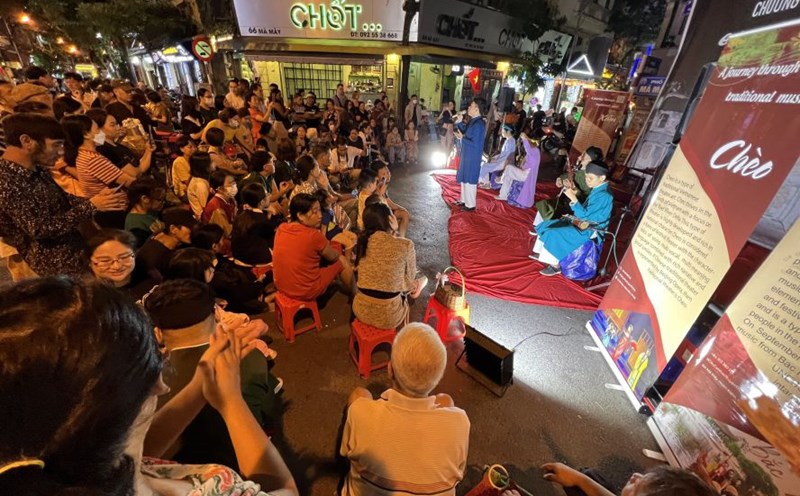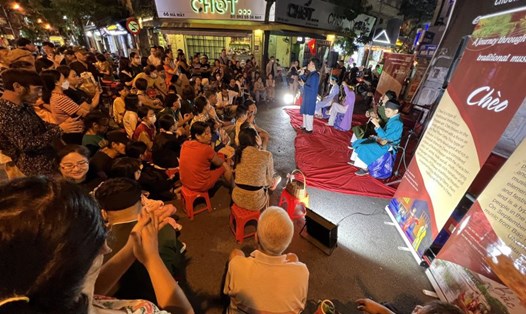Research and criticism of art after works is not a matter of debate, but there is an undeniable point, which is that it helps us have a comprehensive view, covering the process of artistic development at stages, areas as well as the authors, so that we can understand and love art more. In Vietnam, there are not many people who do research and criticism, but art criticism is even more modest.
1.
The names commonly seen in this field include: Thai Ba Van (1934 - 1999), Nguyen Quan (1948), Phan Cam Thuong (1957), and a special person - a painter from the Indochina period, who took responsibility for leading the Vietnam Fine Arts Institute, building the Vietnam Fine Arts Museum: Researcher, art critic Nguyen Do Cung (1912 - 1977).
The advantage of a researcher and art critic who is also a painter is his knowledge of the profession, thereby having satisfactory and profound analysis, explanation, evaluation, and assessment of the artistic problem.
Critic Nguyen Quan, in an art talk (the exhibition area of his "Unicorities" and "Movement in stillness" by Japanese sculptor Katsumi Mukai at the Vietnam Fine Arts Museum, November 2024) said: The weakest point of research and criticism in our country is the lack of a foundation for philosophy and theoretical awareness. When there is a lack of this platform, criticism only stops at the sight, not criticism goes further.
Mr. Nguyen Quan also shared: The updated situation and research of Vietnamese art history have better achievements in terms of documentation, classification and coverage of the issue. As for art criticism, many new types of criticism have appeared, including criticism of the market (advertising to attract buyers), criticism of the purpose of art education (suggesting to people who love art), in addition to criticizing professional careers with artistic nature.
Artists often like criticism to deeply mention artistic issues, but there are also people who like criticism to "create" a position and reputation for them. According to Mr. Nguyen Quan, this "exorbitant" criticism will be very harmful, "practic, profitable".
In another interview with artist Tran Huy Oanh 5 years ago (May 5 2020), artist Huy Oanh said that in the era of a flat world where the speed of information develops rapidly and strongly like today, people are able to communicate, become smart and knowledgeable, then stimulating creativity, discovering and accepting new things will be more favorable because they are not too influenced by factors of social awareness and social ethics like the limited information periods before.
Although the law of art development cannot be stopped, if the created aesthetic values are properly evaluated and immediately honored, the artistic development process in general will be faster; instead of being properly recognized and evaluated, the development process will be slow down.
2.
" chatting with painting" - a newly released book by artist Le Thiet Cuong, collects about 70 articles on Vietnamese fine arts published in many newspapers and magazines over nearly 20 years (2006 - 2024). According to the forms of criticism mentioned by art researcher Nguyen Quan above, the book can be classified as the second and third forms, because the article is both educational and artistic and analyzes both the expertise and the culinary profession.
In addition to the cover, books are moderately written about the category: Art commentary. This means that the author is ready to focus on average and comment on the beauty, the beauty of the author - the work without the intention of query to consider criticism. Le Thiet Cuong called this "chatting", in order to bring a sense of intimacy, not serious, or rigid, although his intentions are often neat and clear. "Painting" is not only a picture, it can be a ceramic jar, a statue, a beauty that is "painted" in the immediate future.
Going from a specific work, from its own form, from which to build the author of that work (an individual, a group of people) is Le Thiet Cuong's approach. Each portrait is identified but does not look big and big. "A party admission session", "Beauty in the shelter", "Dream garden", "rice seller" or "War and peace", "Rain and wind swept away", "The great words", "Two sighing in the afternoon of the city", "whispering", "golden" ... titles like music are smooth enough, hope, full of love. The rhythm of the painting plus music, writing into words is also one more memory, storage, sharing.
Le Thiet Cuong is not too much, when saying that writing is also a way to learn. Not only for painting, this method is also true for many fields. The coverage of language is not limited by imagination and expression, it can represent a specific thing but can also specifically a very vague feeling. When the sentences are no longer disjointed and relaxed but are arranged, they naturally become lines, lines, routes, and blocks, making what we feel like we can be clear, as profound as holding, grasping.
The book mentions familiar names that many people know, and even names that few people know better, famous people and "newcomers". Artists of the school such as: Nguyen Phan Chanh, Nguyen Tu Nghiem, Duong Bich Lien, Nguyen Sang, Bui Xuan Phai, Luu Cong Nhan, Tran Luu Hau, Nguyen Hai... or artists with a lot of instinct such as: Van Cao, Dang Dinh Hung, Tran Trung Tin, Trinh Cong Son, seem to have no comparison to distinguish under the eyes of Le Thiet Cuong. Art in every form, coming out of their own lives, contributes to the appearance of Vietnamese fine arts history.
As a quiet and proficient person, people may think that Le Thiet Cuong wholeheartedly wrote to "please" his colleagues. But the article is printed into a public book, if readers are still wondering, time will tell them the answer. The paintings he collected by his colleagues are unlikely to be a lie. Each person's concepts and preferences can be different, so it is understandable that Le Thiet Cuong's subjectivity in his articles or choosing paintings.
Appearing at the launch of the book " chatting with painting" are also 40 paintings from the artist's own collection (Gallery39), the authors of which are the artists he mentioned in his book. It is easy to recognize that Le Thiet Cuong likes the beauty of something unreal, poetic, and is a little reflective. The mixed things, let him chat, calm down, let his soul rest and rest.
The book " chatting with painting" is part of the latest collection of artist Le Thiet Cuong, after the book "House & People" introduced in August 2024. The book is over 500 pages thick, published by the Writers Association Publishing House.
Exhibition of 40 paintings in the collection from June 3 to 13, 2025, at Hoi Nha Van Publishing House, 65 Nguyen Du, Hai Ba Trung, Hanoi.











